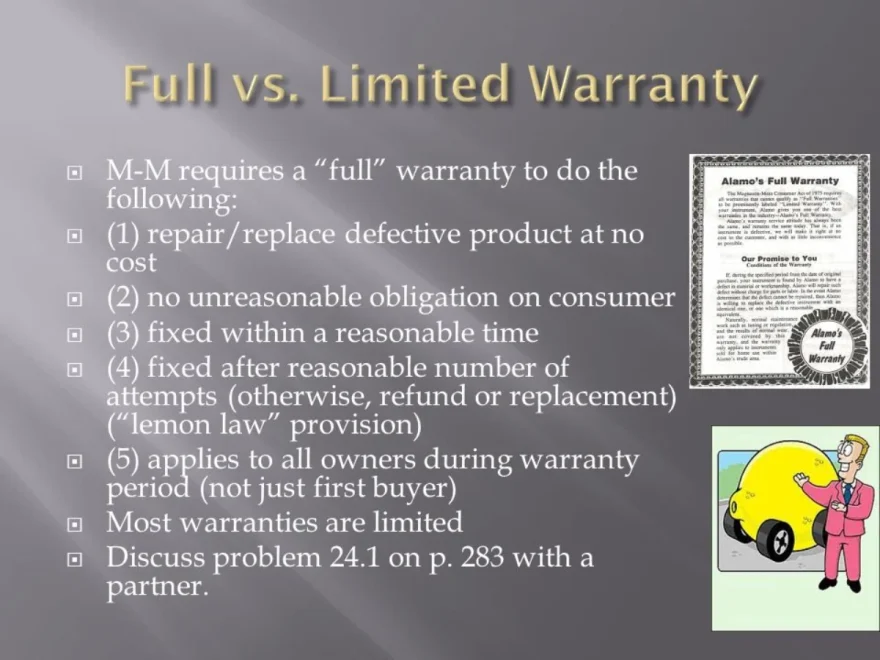Introduction
When making a significant purchase, whether it’s a car, electronic device, or home appliance, understanding the warranty that comes with it is crucial. Two common types of warranties you’ll encounter are full warranties and limited warranties. In this article, we’ll break down the key differences between these two types of warranties, helping you make informed decisions when shopping for products.
Full Warranty: What Does It Mean?
Defining a Full Warranty
A full warranty, also known as a “bumper-to-bumper” or “comprehensive” warranty, is a type of warranty that covers nearly all aspects of a product for a specified period. Here are the key features of a full warranty:
- Comprehensive Coverage: A full warranty typically covers all parts and labor required to repair any defects or malfunctions in the product.
- Duration: The duration of a full warranty varies by product and manufacturer but often ranges from one to three years.
- No Additional Costs: During the warranty period, the manufacturer or seller is responsible for covering repair costs, including parts and labor. Consumers usually don’t have to pay for these repairs.
Limited Warranty: What Does It Mean?
Defining a Limited Warranty
A limited warranty, as the name suggests, offers coverage that is restricted or limited in certain ways. Here are the key features of a limited warranty:
- Specific Coverage: A limited warranty outlines precisely what aspects of the product are covered and for how long. It may cover certain components or specific types of defects.
- Duration: Like full warranties, the duration of a limited warranty varies but tends to be shorter. It can range from 90 days to a few years.
- Additional Costs: Unlike full warranties, limited warranties may require the consumer to bear some or all of the repair costs. This often includes labor or shipping charges.
Key Differences Between Full and Limited Warranties
Now, let’s explore the critical differences between full and limited warranties:
1. Coverage Extent
- Full Warranty: Offers comprehensive coverage, including all parts and labor for the product.
- Limited Warranty: Provides specific and often restricted coverage, focusing on certain components or defects.
2. Duration
- Full Warranty: Typically has a longer duration, lasting one to three years or more.
- Limited Warranty: Tends to have a shorter duration, often ranging from 90 days to a few years.
3. Additional Costs
- Full Warranty: Generally, consumers do not incur additional costs for repairs during the warranty period.
- Limited Warranty: This may require consumers to pay for labor, shipping, or certain repair costs.
4. Transparency
- Full Warranty: Typically provides clear and comprehensive coverage details.
- Limited Warranty: Requires careful examination of the warranty terms to understand what is covered and what is not.
Which Warranty Should You Choose?
The choice between a full warranty and a limited warranty depends on your individual needs and the product you’re purchasing. Here are some factors to consider:
- Product Complexity: For complex and expensive products, a full warranty can provide peace of mind.
- Budget: Limited warranties may be more budget-friendly upfront, but be prepared for potential repair costs.
- Product Reliability: Assess the product’s reputation for reliability and the likelihood of defects.
- Duration of Ownership: Consider how long you plan to own the product and whether additional coverage is necessary.
Conclusion
Understanding the difference between full warranties and limited warranties is essential when making informed purchasing decisions. While full warranties offer comprehensive coverage for longer periods, limited warranties can be more budget-friendly but come with specific limitations. Always read and compare warranty terms carefully to choose the one that best suits your needs.
FAQs
1. What is the main difference between a full warranty and a limited warranty?
The main difference is in the extent of coverage. A full warranty offers comprehensive coverage for nearly all aspects of a product, while a limited warranty provides specific and often restricted coverage for certain components or defects.
2. Is a full warranty better than a limited warranty?
Not necessarily. The choice between a full warranty and a limited warranty depends on your individual needs, the product you’re purchasing, and your budget. Full warranties offer comprehensive coverage but may come with a higher upfront cost, while limited warranties can be budget-friendly but have specific limitations.
3. Do I have to pay for repairs during a full warranty?
Typically, no. During the full warranty period, the manufacturer or seller is responsible for covering all repair costs, including parts and labor.
4. Are limited warranties shorter in duration than full warranties?
Yes, limited warranties tend to have a shorter duration, often ranging from 90 days to a few years, while full warranties may last one to three years or more.
5. How can I determine what a warranty covers?
To understand what a warranty covers, carefully read the warranty terms provided by the manufacturer or seller. Look for information on coverage extent, duration, and any additional costs or limitations.
Read More: https://kohlscom-activate.com/
More Related:
If My Car Insurance Is Cancelled, Can I Get It Back with Progressive?
How to Cancel Allstate Renters Insurance: A Step-by-Step Guide
Does Allstate Offer Long-Term Care Insurance?
If I Cancel My Insurance, Do I Get a Refund with Allstate?
Which is Better: AAA or Allstate Roadside Assistance?
How Much Is Full Coverage Car Insurance with Allstate?
eBay Refurbished Allstate Warranty: Your Comprehensive Guide

